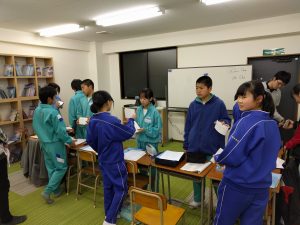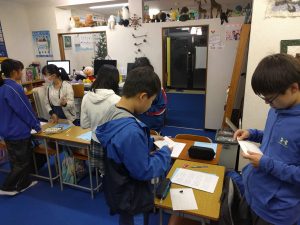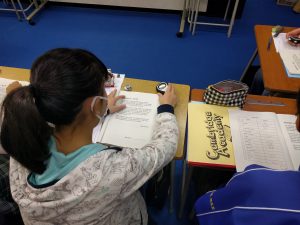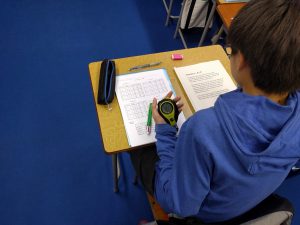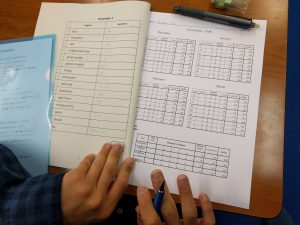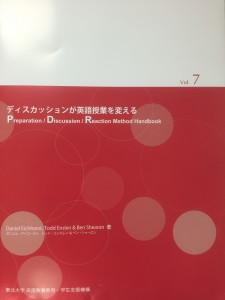conference curriculum extensive reading language courses university
by sendaiben
leave a comment
CLaSIC 2018
I enjoyed attending and presenting at the Eighth CLS International Conference in Singapore this week.
Thank you to everyone that attended my presentation and especially to those that asked questions or talked to me afterwards.
Here are my slides in PDF format:
Please feel free to leave a comment or contact me by email if you have any questions.
Academy curriculum junior high school language courses materials publications school management textbooks
by sendaiben
leave a comment
The Academy Fluency Course
The Cambridge Academy is a six-year English program for junior and senior high school students at Cambridge English School in Sendai. You can read previous Academy posts here:
- Extensive Reading for Secondary Students (April 2015)
- Six Months In (September 2015)
- Year One (February 2016)
- Looking at Year Two (March 2016)
- Stocktake (March 2016)
- Shadoku explained (April 2016)
- Some improvements to the curriculum (April 2016)
- December 2016 update (December 2016)
- Cambridge Academy: Year Two and Three (March 2017)
- Cambridge Academy: Stocktake 2017 (March 2017)
- Cambridge Academy: Another Quantum Leap (April 2017)
- Cambridge Academy: Year Three Mid-Year Update (August 2017)
- Cambridge Academy: Year Three Student Progress (October 2017)
- Cambridge Academy: Year Three and Four (February 2018)
Background
The fluency course was not originally part of the Academy plan. Originally I wanted to run the Academy purely as an extensive reading course that would supplement what students were doing at school (and cram school/juku). This is much easier logistically and makes scheduling and running classes very simple. It’s also more profitable as you can fill classes with students of different levels.
This first iteration of the Academy did not work well. We found that without help it was difficult for students to learn English just from reading. We also found that students did not form a social bond with the school or their peers and thus missed out on motivation. Some students did well with the ER-only model, but many did not.
The second iteration of the Academy imitated SEG in having reading classes and communication classes. For the latter we used commercial textbooks. This worked better than ER-only, but there were problems with the tone, content, amount of material, and amount of repetition in the textbooks. The classes also worked well if run by an experienced engaged teacher but less well with less experienced teachers.
In order to deal with these problems, we created the Academy Fluency Course. It was written from scratch, extensively trialled with our classes here, and is designed to provide students with huge amounts of repetitive practice in reading, speaking, listening, and writing. Fluency is gained by repeating tasks you can already do, and the goal of the Fluency Course is not to teach students new language (although they do encounter huge amounts of new vocabulary and grammar in the course) but rather to allow them to practice enough to internalise some of the language they know and become fluent in using it.
The Cambridge Academy now consists of 140 minute classes: 20 minutes of workbook/school work/individual study, 60 minutes of input (extensive reading and listening), and 60 minutes of output (fluency course).
The Academy Fluency Course
Junior high school 1: Year One (these materials are in beta and are described in detail below).
The theme for this level is the students daily and school lives.
Junior high school 2: Year Two (these materials are in alpha).
The theme for this level is Japan. Students read and talk about different areas/aspects of Japan.
Junior high school 3: Year Three (these materials are not written yet).
The theme for this level is the world. Students read and talk about different areas/aspects of the world.
Senior high school initial course for first and weaker second years: (these materials are not written yet).
This level will provide a transition between the junior high school materials and the advanced course below.
Senior high school advanced course for stronger second and third years: (this is being written now).
This level is based on the PDR method and involves students reading, thinking, discussing, and writing about topics each week.
In 2017 we ran classes using the Year One materials. Halfway through the year we started writing the Year Two materials with the second and third graders. The plan is to write Year Three this year alongside the advanced high school course and to use them with the third year JHS and our advanced high school class.
Fluency Course Year One
The first year of the Fluency Course is based on the first year junior high school textbooks and has the following student components:
- 12 4-week student textbooks (April to March) with a total of 512 pages and 84,249 words
- a 48-unit student writing workbook
- 12 monthly reference sheets with questions and vocabulary
- 3 4-month student record sheets
There are also reference/class/teacher components
- 240 index cards with questions and answers (you will need one set for every two students in the class for pair work)
- 48 verb exercise answer sheets (you will need one for each student in your largest class)
- 48 Quizlet vocabulary and question datasets (available through the Quizlet website)
The main component is the student textbook, split into twelve montly booklets. It provides the vocabulary and questions for all the other components. The April book is slightly different from the others because it provides a gentle introduction. Each book contains the following:
Week One and Two
Vocab quiz (15 items from the timed reading texts, previewed by Quizlet)
3 timed reading texts with questions (April 45 words, May-July 60 words, August-November 80 words, December-March 100 words)
Verb conjugation table (to be read aloud -one verb per week)
Timed verb translation (30 items)
Example dialogue for reading and memorizing (April-July 3 exchanges, August-November 4 exchanges, December-March 5 exchanges)
Week Three
No example dialogue. Instead students write their own (length as above).
April has example dialogue.
Week Four
Instead of three short timed readings, there is one reading with three times the word count.
Teacher corrects and chooses the best student dialogues, then prints them for students to practice with.
April has example dialogue.
Results
The Fluency Course depends somewhat on the fact that students are also learning English at school. It is designed to cover the gaps in students learning, mainly speaking, reading, and writing exercises, and particularly drilling these.
So far results have been very encouraging. Our students are not all particularly academic or motivated, and it has been very encouraging to see all of them improve and succeed using the Fluency Course. More able/advanced students are able to challenge themselves within the course, while weaker ones can support themselves and keep up.
I will write a description of an output class in a future blog post.
Preparation Discussion Reaction: The PDR Method
How to get students speaking, discussing, and writing about real topics
Almost two years after it was first published, the PDR Handbook is finally available online.
PDR is a groundbreaking method for running 4-skills language classes for intermediate and above students. It can also be adapted for use with content classes. I have also used it successfully for teacher workshops.
You can download a copy of the Handbook in PDF format from here.
Academy curriculum extensive reading goals high school junior high school language courses school management
by sendaiben
4 comments
Cambridge Academy: Year Three Student Progress
Encouraging developments
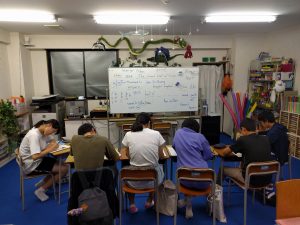
Second-year junior high school students in the output class
You can read previous Academy posts here:
- Extensive Reading for Secondary Students (April 2015)
- Six Months In (September 2015)
- Year One (February 2016)
- Looking at Year Two (March 2016)
- Stocktake (March 2016)
- Shadoku explained (April 2016)
- Some improvements to the curriculum (April 2016)
- December 2016 update (December 2016)
- Cambridge Academy: Year Two and Three (March 2017)
- Cambridge Academy: Stocktake 2017 (March 2017)
- Cambridge Academy: Another Quantum Leap (April 2017)
- Cambridge Academy: Year Three Mid-Year Update (August 2017)
The Academy is still going well. I’m having a lot of fun and I think at least some of the students are enjoying it too 😉
We lost one more student on average (lost three, gained two), but I think this is normal and it isn’t something that worries me. The students who are leaving tend to be our older students who started before the Academy existed and haven’t benefited as much as our newer students will from improved lessons and system. Here are our latest numbers:
Right now we have 78 students:
- 32 junior high school first years (29 regular, 2 reading only, 1 advanced)
- 21 junior high school second years (15 regular, 4 reading only, 2 advanced)
- 8 junior high school third years (5 regular, 3 reading only)
- 7 senior high school first years (4 regular, 3 reading only)
- 6 senior high school second years (5 regular, 1 reading only)
- 2 senior high school third years (2 regular)
- 2 ronin students (1 regular, 1 reading only)
It looks like we’re going to fill our first year output classes, as one student has changed to output after a few months of tutoring, and a trial student last week is going to try to do the same.
Today I’m going to share the students’ reading numbers. This gives some idea of how much our students are reading given an hour in class (probably more like 50-55 minutes) and for a few of them also reading at home. All numbers are up to date as of today.
First year (six months or so): 16,885-111,509 (most students are in the 30,000-50,000 range), YL0.2-0.4
Second year (eighteen months or so): 75,850-354,976 (most students are in the 120,000-160,000 range), YL0.3-0.6
Third year (thirty months or so): 197,892-748,564 (most students are around 300,000), YL0.6-4.0
You can’t really tell from the numbers above, but each year is reading more/better/faster than the years above them. Our current first years seem to be doing much better than our current second years did in their first year, who did better than our current third years did in their first year. I predict our current first years will be hitting 500,000 words by the end of junior high school, which should set them up to read a couple of million by the time they finish high school.
We need to continue buying intermediate books, and I am working on that. I am trying to find more leveled readers and books aimed at native speakers rather than graded readers (which tend to be a bit more dry). We already have mostly graded readers anyway. Students who find a series they like (Magic Tree House is very popular) and then read all the books in the series tend to do very well in terms of motivation and reading progress.
I have pretty much decided not to increase class sizes above ten, mostly due to the physical constraints of our current classrooms. I think we could do twelve easily, and probably up to twenty, but we just don’t have the room.
In terms of who will teach the classes, I am hoping to assign a teacher to each class next year. I will then join certain classes to model, observe, give feedback, etc. This should allow me to develop the system and get more of a birds’ eye view. Eventually it should allow me to take a step back with regards to the actual teaching too (and maybe open another school, but that’s a different blog post).
What do you think? What are your students’ numbers like? Any good intermediate books/series I could get?
Cambridge Academy: Year Three Mid-year Update
Incremental Change
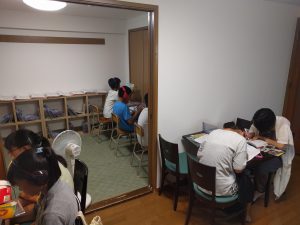
Monday junior high school first-years
You can read previous Academy posts here:
- Extensive Reading for Secondary Students (April 2015)
- Six Months In (September 2015)
- Year One (February 2016)
- Looking at Year Two (March 2016)
- Stocktake (March 2016)
- Shadoku explained (April 2016)
- Some improvements to the curriculum (April 2016)
- December 2016 update (December 2016)
- Cambridge Academy: Year Two and Three (March 2017)
- Cambridge Academy: Stocktake 2017 (March 2017)
- Cambridge Academy: Another Quantum Leap (April 2017)
We’re almost halfway through year three of the Cambridge Academy. As I wrote about in the last update we’re trying out our new Fluency Course this year along with larger classes (up to ten students). I’m also teaching six nights a week.
Right now we have 79 students:
- 31 junior high school first years (28 regular, 2 reading only, 1 advanced)
- 21 junior high school second years (15 regular, 4 reading only, 2 advanced)
- 8 junior high school third years (5 regular, 3 reading only)
- 8 senior high school first years (5 regular, 3 reading only)
- 6 senior high school second years (4 regular, 2 reading only)
- 3 senior high school third years (2 regular, 1 reading only)
- 2 ronin students (2 regular)
So far, so good. The Fluency Course is going well with the first years, who are using it as their only materials. For the second and third years we have been using the first year timed reading texts alongside our original question cards and workbooks, as well as commercial textbooks.
From this month the third years have been trying our second year Fluency Course. Right now we only have the first month written, so we have to write each month in order for the students to use it the following month. I am writing the second month as we speak (well, actually I am procrastinating by writing this blog post instead!).
The junior high school students are streamed by school year (we have three first year, two second year, and one third year class), apart from advanced students who either get private classes or join a senior high school class. Senior high school students are streamed by level/ability, and we currently have three levels/classes.
We made another big book order for YL0.3 and 0.4 taking us to roughly ten copies of each set, and I think we’ll probably do the same for 0.5 and 0.6 later in the year.
The main developments have been in the input (reading) classes, and how we approach them now and in the future.
At this point it seems like our current first years are doing better than our first years last year. I can think of several reasons. We made student manuals to help explain the system. We modeled what we wanted to see in the reading classes, both at the beginning and several weeks in when we saw that some students were going off track. We introduced a read to the teacher extra step when students finish a set.
It seems likely that we should be able to aim for our students to reach intermediate level (YL1.1+) by the end of the third year of our course, having read over half a million words. If they then choose to stay with us during senior high school, we can try to get them to the lift-off stage where they go on to read 1-2 million words over the following three years.
However, we are still not achieving the results that some of the best ER programs in Japan boast. This month I attended the Extensive Reading World Congress and was able to attend some very inspiring presentations by Japan Extensive Reading Association members.
I learned two important things:
- The results reported by some programs seem to be outlier students chosen for effect and do not represent the average student. In the case of SEG, they have three levels of class (advanced, normal, and low-level). Due to their student demographics (large number of returnees and kids expecting to get into Tokyo University), our student population is closest to their low-level classes, and we are achieving similar results so I feel much better about our program now.
- With guided ER it is important not to increase student levels linearly, but instead to have them fluctuate up and down. This is expressed in the concepts of kirin (giraffe) reading, where students read above their baseline level, and panda reading, where they read below. Through judicious use of these two variations, we should be able to have our students progress slightly faster than they have done until now.
We have identified three types of student at our school, each of which requires slightly different treatment.
Fast students: can advance quickly, only reading a couple of books/sets at each level. Goals are to get to intermediate then find a series they enjoy in order to do narrow reading. I think our current approach is fine with these students, but we might be able to do better at introducing books/encouraging them to stretch themselves.
Normal students: can advance at a normal pace, reading about 2/3 of our readers at each level while also doing kirin reading and panda reading. Goals are to level up as quickly as possible without getting ahead of their understanding. I think we can help these students move quicker by judicious coaching.
Slow students: can advance only slowly, often requiring extra reading at each level before moving up. Kirin reading may help these students and is something we will investigate. Perhaps we could provide more support by reading with these students or helping them understand/interact with the texts.
Compared to SEG, we have about half the in-class reading time, and much more importantly a much less motivated and academically-gifted student body. Despite these restrictions, I am hopeful we’ll be able to help most of our students achieve meaningful progress in their English skills.
The obstacle is that even for SEG it seems to take 4-5 years before the effects really start to show. Getting students (and their parents) to persist until they reap the benefits of their effort seems to be the tricky part. We’re getting better at this, and are losing fewer students than we were in the first year.
Last year we almost filled our three classes of ten. It looks like we’ll have around thirty students coming up from elementary school classes, so should have similar numbers in April.
Things I need to figure out before next year:
- Do we increase our class limits to twelve? I think it would work pedagogically, and of course it would make the classes more profitable, but we’d really be stretching the physical limits of both our input and output classrooms. Right now ten is snug, so twelve might be too tight.
- Who is going to teach the classes? We could go in one of four directions: I keep teaching both input and output classes, alongside other teachers and our interns. I teach all the output classes, and leave the input classes to our interns. I leave the output classes to our teachers and teach all the input classes. I ask our teachers and interns to teach all the classes, and float, observing and helping as needed. I think it might be a bit soon for the last option.
Running the Academy is still one of the most fun and interesting things I have done as a teacher, and I am really looking forward to figuring out how to make the program even better over the next few years.
